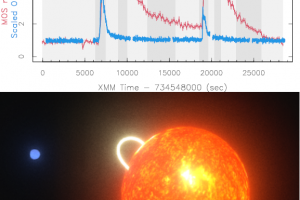Two bright flares in DS Tuc A and their impact on the nearby planet. The paper: “X-ray flares of the young planet host Ds Tucanae A” of I. Pillitteri recently appeared on A&A

Flares are among the most energetic magnetic phenomena occuring in stars. They are triggered by a sudden release of energy previously stored in the stellar magnetic field, and then they culminate with the formation of magnetic loops in the stellar coronae filled by X-ray and UV emitting plasma at million degrees. Sometimes, these magnetic structures erupt, releasing in the surrounding space hot plasma. These phenomena are called “coronal mass ejections” (CME). Both flares and CMEs are often observed in the Sun.
The energy released by these phenomena, and their frequency, decline with stellar age. This is due to the slow down of stellar spin, since both the morphology and the intensity of the stellar magnetic fields are related to their rotational velocity. In a few million of years old stars, for instance, flares can release thousands of times more energy than those observed on the Sun. These magnetic phenomena can also have a strong impact on planets recently formed around young stars. Flares are in fact sources of intense UV and X-ray radiation. This energetic radiation can be absorbed by the atoms and molecules in the outer layers of exoplanets atmospheres, rising gas temperature and making it expand and evaporate. Energetic radiation can also trigger chemical reactions that can alter the abundance of specific chemical elements. In the most extreme cases, strongly irradiated exoplanets can loose a large fraction of their initial mass.
The star DS Tuc A (spectral class G6 and part of a binary system with a K3 star) is a perfect laboratory to test the effects of energetic radiation onto young exoplanets. DS Tuc A, in fact, is a 40 million years old star, and it hosts a planet (DS Tuc Ab) with a radius of 0.5 Jupiter radii, a mass upper limit of 14.4 Earth masses, and an orbital period of only 8.14 days. Recent studies led by astronomers of INAF – Astronomical Observatory of Palermo have demonstrated that bright flares are quite frequent in this star, and that the planet has a very low density with an evaporating atmosphere. A more recent study led by the astronomer I. Pillitteri (INAF – Astronomical Observatory of Palermo), based on observations obtained with the X-ray satellite XMM-Newton of the European Space Agency, presents the detection and analysis of two bright flares in DS Tuc A. The two flares lasted about 130 and 170 minutes, and they released a total of 5×1034 e 8×1034 erg of energy in the X-ray bands. As comparison, the brightest X- ray flares in the Sun release at most 1032 erg of energy. During their peaks, the X-ray irradiation on the planet increased by a factor of 10 compared with the quiescence (which is the period with no flares), potentially inducing ionization of the outer layers of its atmosphere. Besides, such a strong flares are typically accompanied with intense CMEs. The authors have calculated that the amount of ejected plasma shoudl be about 5×10-15 solar masses, with a velocity of about 1000 km/s. With this velocity, the CME should reach the planet after 3 hours. Recent theoretical studies suggest that such a phenomenon should drastically increase the evaporation rate of the planetary atmosphere. The study is described in the paper: “X-ray flares of the young planet host Ds Tucanae A“, recently appeared on Astronomy & Astrophysics. The list of coauthors includes the astronomers A. Maggio, G. Micela, S. Benatti, and S. Colombo of INAF – Osservatorio Astronomico di Palermo, together with C. Argiroffi and F. Reale of the University of Palermo and astronomers of the Harvard-Smithsonian Center for Astrophysics.
The figure (click here to visualize the entire image) shows in the upper panels the light curves (which are the time variability of the source luminosity) in the UV (blue line) and X-rays (red lines) bands during the flares. The two light curves show the typical variability observed during flares, with a sudden increase of luminosity followed by a slow decline. The bottom panel shows a model of the geometry of the coronal loop.
Mario Giuseppe Guarcello ( follow mguarce) ( youtube)
Follow the Astronomical Observatory of Palermo on Facebok
Subscribe the Youtube channel of the Astronomical Observatory of Palermo
